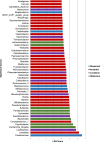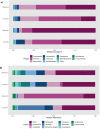The healthy equine uterus harbors a distinct core microbiome plus a rich and diverse microbiome that varies with geographical location
- PMID: 36042332
- PMCID: PMC9427864
- DOI: 10.1038/s41598-022-18971-6
The healthy equine uterus harbors a distinct core microbiome plus a rich and diverse microbiome that varies with geographical location
Abstract
The goal of this study was to understand the composition and existence of the resident uterine microbiome in healthy mares and to establish the presence of a core microbiome for the healthy equine uterus. We analyzed the microbiomes of 35 healthy mares that are long-time residents of three farms in Oklahoma, Louisiana, and Australia as well as that of 19 mares purchased from scattered owners in the Southern Mid-Western states of the United States. Over 6 million paired-end reads of the V4 region of the 16S rRNA gene were obtained resulting in 19,542 unique Amplicon Sequence Variants (ASVs). ASVs were assigned to 17 known phyla and 213 known genera. Most abundant genera across all animals were Pseudomonas (27%) followed by Lonsdalea (8%), Lactobacillus (7.5%), Escherichia/Shigella (4.5%), and Prevotella (3%). Oklahoma and Louisiana samples were dominated by Pseudomonas (75%). Lonsdalea (28%) was the most abundant genus in the Australian samples but was not found in any other region. Microbial diversity, richness, and evenness of the equine uterine microbiome is largely dependent on the geographical location of the animal. However, we observed a core uterine microbiome consisting of Lactobacillus, Escherichia/Shigella, Streptococcus, Blautia, Staphylococcus, Klebsiella, Acinetobacter, and Peptoanaerobacter.
© 2022. The Author(s).
Conflict of interest statement
The authors declare no competing interests.
Figures








Similar articles
-
Hot topic: 16S rRNA gene sequencing reveals the microbiome of the virgin and pregnant bovine uterus.J Dairy Sci. 2017 Jun;100(6):4953-4960. doi: 10.3168/jds.2017-12592. Epub 2017 Apr 21. J Dairy Sci. 2017. PMID: 28434745 Free PMC article.
-
Metagenomic analysis unravels novel taxonomic differences in the uterine microbiome between healthy mares and mares with endometritis.Vet Med Sci. 2024 Mar;10(2):e1369. doi: 10.1002/vms3.1369. Vet Med Sci. 2024. PMID: 38357732 Free PMC article.
-
The female upper reproductive tract harbors endogenous microbial profiles.Front Endocrinol (Lausanne). 2023 Jun 21;14:1096050. doi: 10.3389/fendo.2023.1096050. eCollection 2023. Front Endocrinol (Lausanne). 2023. PMID: 37415669 Free PMC article.
-
Metagenomic characterization of the equine endometrial microbiome during anestrus.J Equine Vet Sci. 2024 Sep;140:105134. doi: 10.1016/j.jevs.2024.105134. Epub 2024 Jun 21. J Equine Vet Sci. 2024. PMID: 38909766
-
The evidence for placental microbiome and its composition in healthy pregnancies: A systematic review.J Reprod Immunol. 2022 Feb;149:103455. doi: 10.1016/j.jri.2021.103455. Epub 2021 Nov 30. J Reprod Immunol. 2022. PMID: 34883392
Cited by
-
Reproductive Tract Microbiota of Mares.Vet Sci. 2024 Jul 18;11(7):324. doi: 10.3390/vetsci11070324. Vet Sci. 2024. PMID: 39058008 Free PMC article. Review.
-
Metagenomic and proteomic analyses reveal similar reproductive microbial profiles and shared functional pathways in uterine immune regulation in mares and jennies.PLoS One. 2025 Apr 16;20(4):e0321389. doi: 10.1371/journal.pone.0321389. eCollection 2025. PLoS One. 2025. PMID: 40238748 Free PMC article.
-
Genome Sequence Comparisons between Small and Large Colony Phenotypes of Equine Clinical Isolates of Arcanobacterium hippocoleae.Animals (Basel). 2024 May 29;14(11):1609. doi: 10.3390/ani14111609. Animals (Basel). 2024. PMID: 38891657 Free PMC article.
-
Vaginal and Uterine Microbiota of Healthy Maiden Mares during Estrus.Vet Sci. 2024 Jul 18;11(7):323. doi: 10.3390/vetsci11070323. Vet Sci. 2024. PMID: 39058007 Free PMC article.
-
The Role of Biofilms in the Pathogenesis of Animal Bacterial Infections.Microorganisms. 2023 Feb 28;11(3):608. doi: 10.3390/microorganisms11030608. Microorganisms. 2023. PMID: 36985183 Free PMC article. Review.
References
Publication types
MeSH terms
Substances
LinkOut - more resources
Full Text Sources

